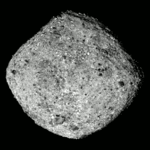Astronomy:2017 YZ1
| Discovery [1] | |
|---|---|
| Discovered by | Mount Lemmon Srvy. |
| Discovery site | Mount Lemon Obs. |
| Discovery date | 20 December 2017 (first observed only) |
| Designations | |
| 2017 YZ1 | |
| Minor planet category | NEO · PHA · Apollo [1][2] |
| Orbital characteristics [2] | |
| Epoch 23 March 2018 (JD 2458200.5) | |
| Uncertainty parameter 6 | |
| Observation arc | 53 days |
| |{{{apsis}}}|helion}} | 1.7717 AU |
| |{{{apsis}}}|helion}} | 0.8828 AU |
| 1.3272 AU | |
| Eccentricity | 0.3349 |
| Orbital period | 1.53 yr (559 d) |
| Mean anomaly | 352.80° |
| Mean motion | 0° 38m 40.56s / day |
| Inclination | 20.875° |
| Longitude of ascending node | 277.76° |
| 298.39° | |
| Earth MOID | 0.0000357 astronomical unit|AU (0.0139 LD) |
| Physical characteristics | |
| Mean diameter | 0.26 km[3] |
| Absolute magnitude (H) | 20.4[2] |
2017 YZ1 is a sub-kilometer asteroid on an eccentric orbit, classified as near-Earth object and potentially hazardous asteroid of the Apollo group, approximately 250 meters (800 feet) in diameter. It was first observed on 20 December 2017, by astronomers of the Mount Lemmon Survey at Mount Lemmon Observatory near Tucson, Arizona, in the United States.[1][3] On 29 January 2018, it passed Earth at 125 lunar distances.[2]
Orbit and classification
2017 YZ1 is a member of the Apollo asteroids, which cross the orbit of Earth. Apollo's are the largest group of near-Earth objects with nearly 10 thousand known objects.
It orbits the Sun at a distance of 0.88–1.77 AU once every 18 months (559 days; semi-major axis of 1.33 AU). Its orbit has an eccentricity of 0.33 and an inclination of 21° with respect to the ecliptic.[2]
Risk assessment
The 9 January 2018 solution with a 15-day observation arc was listed at Torino scale 1 with a 1:21,000 chance of impacting Earth on 30 June 2047. By 9 January 2018, the geocentric 30 June 2047 uncertainty region had shrunk to ±50 million km. With a longer 20 day observation arc, it dropped to Torino scale 0 and had a 1:670,000 chance of impacting Earth on 30 June 2047.[3] On 18 January 2018 it was removed from the Sentry Risk Table. With a 28-day observation arc, the nominal solution suggests it will be about 0.25 AU (37,000,000 km) from Earth on 30 June 2047. The 3-sigma uncertainty in the 2047 close approach distance is about ±13 million km.
Numbering and naming
This minor planet has neither been numbered nor named.[1]
See also
- List of asteroid close approaches to Earth in 2018
References
- ↑ 1.0 1.1 1.2 1.3 "2017 YZ1". Minor Planet Center. https://www.minorplanetcenter.net/db_search/show_object?object_id=2017+YZ1. Retrieved 21 March 2018.
- ↑ 2.0 2.1 2.2 2.3 2.4 "JPL Small-Body Database Browser: (2017 YZ1)". Jet Propulsion Laboratory. https://ssd.jpl.nasa.gov/sbdb.cgi?sstr=3794988. Retrieved 21 March 2018.
- ↑ 3.0 3.1 3.2 "Earth Impact Risk Summary: 2017 YZ1". NASA/JPL Near-Earth Object Program Office. https://cneos.jpl.nasa.gov/sentry/details.html#?des=2017%20YZ1.
External links
- MPEC 2017-Y79 : 2017 YZ1, Minor Planet Electronic Circular
- CNEOS – Center for Near Earth Object Studies, NASA
- List Of Apollo Minor Planets (by designation), Minor Planet Center
- List of the Potentially Hazardous Asteroids (PHAs), Minor Planet Center
- Case Study of 2017 YZ1: Long-term Impact Monitoring and IAWN, IWAN
- Asteroid 2017 YZ1, at Asteroidsnear.com
- 2017 YZ1 at NeoDyS-2, Near Earth Objects—Dynamic Site
- Ephemeris · Obs prediction · Orbital info · MOID · Proper elements · Obs info · Close · Physical info · NEOCC
- 2017 YZ1 at ESA–space situational awareness
- 2017 YZ1 at the JPL Small-Body Database



